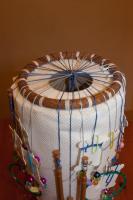Marudai Painter - info
Use Marudai Painter
The friendship wheel, or kumihimo disk started our interest, but once we realised there was more than kongoh-gumi (or kongo gumi) braids out there, we decided to learn more about the marudai. A marudai opens up a wide range of possibilities for design and experimentation, and we hope people will find what we have learnt useful.
Marudai vs Disk
A marudai is different to a disk because it does not have slots for the threads, and uses weights on the braid and the threads to provide the tension. With a kumihimo disk, the grip of the foam on the threads gives the tension. Because there are no slots, you don't need a gap between threads to be able to move an extra thread between them - the threads can be easily adjusted to make space. Also a marudai is a stool-like structure and isn't rotated. The same part of the marudai always faces away from you.
Some of these braids can be done on a disk - as we try them out, and work out methods for doing them, we will add disk instructions for the braids. If you want to work them out yourself, you may need to move threads to different slots to make space for an extra thread to come between. Some of the braids may work better if you do rotate the disk - but remember, the marudai diagrams do NOT rotate.
Some of these braids may work better on a square kumihimo plate. There is a kit from Alex Toys that contains both a kumihimo disk (Friendship Wheel) and a square plate. The pattern for the square plate is Warp 8 7, and there are instructions for making it on the square plate as well as marudai.
Trying a marudai
 Although the foam disk and plates are very convenient for travelling, and easy to set up, braiding on a marudai is much easier once you get started. A proper marudai is made from a good hardwood, so can seem expensive, but if you do a lot of braiding, you will probably find you are a lot faster using it. I started out with a cheap "marudai" - a roll of kitchen towel as a stand, and bobbins were a mix of lace bobbins and cheap plastic thread bobbins weighted with a few plastic beads. There were many disadvantages - the bobbins tangled and didn't untwist as they were held agains the kitchen towel but it was enough to convince me it was worth making a better marudai. My current one is softwood, so I keep some sandpaper handy to smooth minor damage, but I am planning a proper hardwood mirror (or top).
Although the foam disk and plates are very convenient for travelling, and easy to set up, braiding on a marudai is much easier once you get started. A proper marudai is made from a good hardwood, so can seem expensive, but if you do a lot of braiding, you will probably find you are a lot faster using it. I started out with a cheap "marudai" - a roll of kitchen towel as a stand, and bobbins were a mix of lace bobbins and cheap plastic thread bobbins weighted with a few plastic beads. There were many disadvantages - the bobbins tangled and didn't untwist as they were held agains the kitchen towel but it was enough to convince me it was worth making a better marudai. My current one is softwood, so I keep some sandpaper handy to smooth minor damage, but I am planning a proper hardwood mirror (or top).
Although there are quite a few books out there, there seems to be less available in the UK compared to other countries. I got several of mine from the US as I either couldn't get them locally, or they were more expensive (even taking into account shipping). You can see what books I have tried on our books page with suggestions as to whether they are useful for beginners or not.
We believe the structures here are either traditional or worked out by us (although we are sure that someone out there will have tried the patterns before we did).
We originally planned to add a new braid to Marudai Painter every few weeks. Although we haven't added any for a while, we do still intend to add more in future, so keep checking back!
If you have any suggestions for improvement or problems using the tool why not Contact Us
